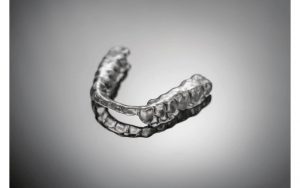A 45-year-old lady came in with a chipped ceramic crown on a back tooth that was fitted 20 years earlier. She remembered that the crown when fitted was “high” which means that it jutted out of the bite and was told that it would settle over time.
Do you remember your last visit to the dentist? Perhaps you may have had a filling done or maybe a cap placed on your tooth? What did it feel like when first put in? Did it feel out of place? Did you say that you would get “used to it” in a couple of days? Well, I have news for you. One NEVER gets used to a filling or a cap that feels out of place when inserted initially. It has to be adjusted by the dentist until it no longer feels like it doesn’t belong in one’s mouth.
Why did I feel it necessary to blog about this? Read on and you will find out.
Back to our patient: When asked specifically about a nocturnal tooth grinding or clenching habit, she replied in the affirmative. She also mentioned that her TMJ (joint) on one side clicked on and off and sometimes felt sore for about a week every year.
If you refer to my other blogs, in several places I have mentioned something called an “interference”. This is a real or artificial tooth that comes in the way of an individual’s bite. Most often it is a wisdom tooth which is the last tooth to fight for room in the mouth. In a “susceptible individual” who is unable to tolerate the slightest of alterations in the mouth, a wisdom tooth or a cap or filling out of place will be the start of many cascading problems that are caused by a bite that is out of place.
Our patient happened to be a “susceptible individual” that could not tolerate an interference and thought that she had gotten used to it. However, at night while asleep she was trying to grind away at that high crown, gradually chipping at the ceramic which was “in the way”. In the process she developed sore muscles around the joint and a clicking noise of the joint. When the new crown was fabricated a thorough bite analysis was carried out so as to make sure that no new interference was unintentionally introduced. A new hard occlusal splint was also fabricated to protect the teeth as a long- standing nocturnal grinding /clenching habit is difficult to get rid of. The patient was relieved of the clicking noise and pain in the joints following the treatment.
So, the next time you get your tooth restored with a filling or a cap, take the time to check whether the tooth feels like it belongs or does it feel out of place? Sometimes it is hard to tell and it can take time to trim. Thinking that it will settle with time is not an option! An apt adage to sum it all would be “A stitch in time saves nine”!


















